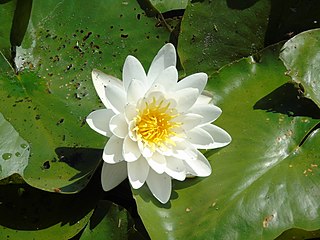
Nymphaea is a genus of hardy and tender aquatic plants in the family Nymphaeaceae. The genus has a cosmopolitan distribution. Many species are cultivated as ornamental plants, and many cultivars have been bred. Some taxa occur as introduced species where they are not native, and some are weeds. Plants of the genus are known commonly as water lilies, or waterlilies in the United Kingdom. The genus name is from the Greek νυμφαία, nymphaia and the Latin nymphaea, which means "water lily" and were inspired by the nymphs of Greek and Latin mythology.

Nuphar is a genus of aquatic plants in the family Nymphaeaceae, with a temperate to subarctic Northern Hemisphere distribution. Common names include water-lily, pond-lily, alligator-bonnet or bonnet lily, and spatterdock.

Nuphar lutea, the yellow water-lily, brandy-bottle, or spadderdock, is an aquatic plant of the family Nymphaeaceae, native to northern temperate and some subtropical regions of Europe, northwest Africa, and western Asia. This species was used as a food source and in medicinal practices from prehistoric times with potential research and medical applications going forward.

Nymphaea mexicana is a species of aquatic plant that is native to the Southern United States and Mexico as far south as Michoacán. Common names include yellow water lily, Mexican water lily and banana water lily.

Nymphaea thermarum, also known as Pygmy Rwandan water lily, is a species of water lily that is endemic to Rwanda. Once thought to be extinct in the wild, all wild plants were believed to be lost due to destruction of its native habitat, but it was thought to be saved from extinction when it was grown from seed at the Royal Botanic Gardens, Kew in 2009. A previously-unknown wild population was discovered in 2023.

Nymphaea gardneriana is a species of waterlily native to Cuba and tropical South America.

Nymphaea paganuccii is a species of waterlily endemic to Brazil.
Nymphaea novogranatensis is a species of waterlily native to Colombia, Mexico, and Venezuela.
Nymphaea × thiona is a species of waterlily native to the US-American states Alabama, Florida, and Georgia. Additionally, it has been introduced to Costa Rica, as well as the US-American states Kentucky, and Nevada. It is a natural hybrid of Nymphaea mexicana and Nymphaea odorata.

Nymphaea gracilis is a species of waterlily endemic to Mexico. It is the only species of its genus which is endemic to Mexico.
Nymphaea guineensis is a species of waterlily native to the region spanning from tropical West Africa to Chad.
Nymphaea maculata is a species of waterlily native to tropical Africa.
Passiflora aurantioides is a species of passion flower native to the region from the Maluku Islands, Indonesia, to Papuasia and Queensland, Australia.
Barclaya motleyi is a species of perennial aquatic plant native to the region spanning from Thailand to Western Malesia, and New Guinea.
Nuphar ulvacea is a species of rhizomatous aquatic plant native to the US-American states Alabama and Florida.
Nuphar orbiculata is a species of rhizomatous aquatic plant native to the US-American states Alabama, Florida, and Georgia.

Nymphaea subg. Brachyceras is a subgenus of the genus Nymphaea.

Nymphaea pygmaea is a controversial species of perennial, aquatic herb in the family Nymphaeaceae native to Asia.

Nymphaea sect. Chamaenymphaea is a section within the subgenus Nymphaea subg. Nymphaea of the genus Nymphaea native to North America, Asia, and Europe.

Nuphar sect. Astylus is a section within the genus Nuphar native to North America.














